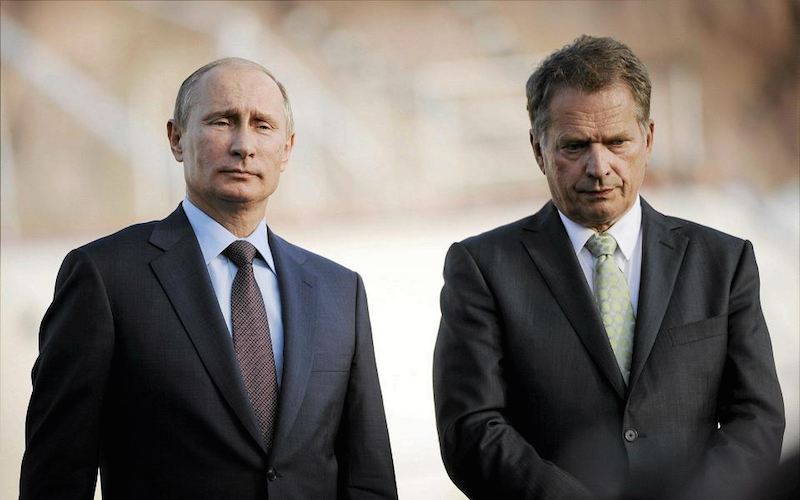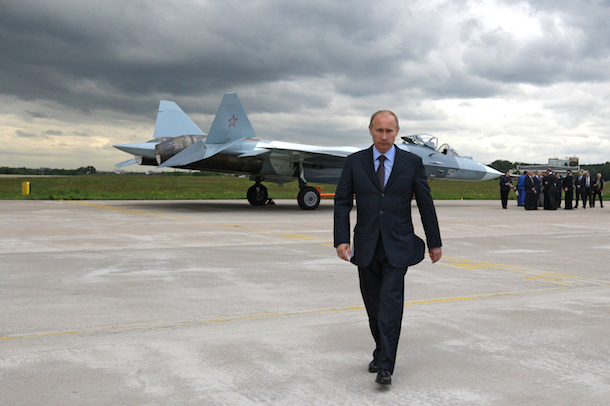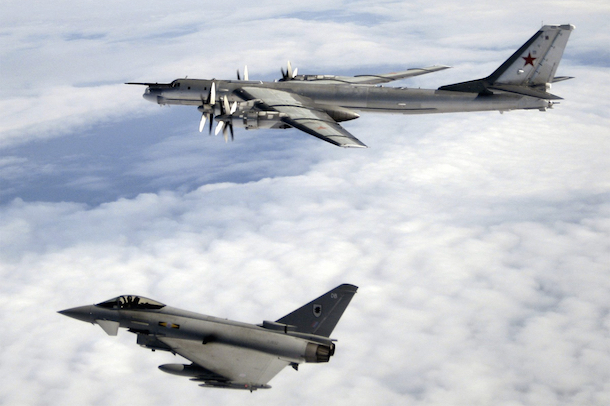
Finland’s Approach towards Quirky Russia: Pragmatically Engaging the Bear
While Russia is stepping up its provocations towards Europe, Russian President Vladimir Putin is now strangely enough also harassing the benign Nordic countries. After Moscow’s annexation of Crimea and its ongoing involvement in the conflict in eastern Ukraine, a Russian submarine supposedly intruded the Swedish archipelago last October. Earlier, Putin commissioned various aerial incursions into Finland. These events have spurred the debate in Finland – where the issue of NATO membership has systematically been ducked – on how to deal with Russia’s encroachment.
Last month, Sauli Niinisto, Finland’s president, painted a gloomy picture of a resuscitated Cold War standoff. He stipulated that the US and EU were partly to blame for this through neglecting Putin’s assertions that the West was hostile to Russian values, and humiliated Moscow with NATO enlargement. With parliamentary elections in Finland coming up in April 2015, the debate on relations with Russia and NATO resurfaces increasingly.
If Finland decides to tighten its military allegiance with the West through NATO membership, it would unnecessarily drive a wedge between them and Moscow. Agility and utilitarianism, as opposed to confrontation and idealism, have proven to be more effective methods for the Finns in dealing with their heavy-weight neighbor. There is no reason to believe that this will be any different in the future.
Finland shares a border of 830 miles with its eastern neighbor, rendering Russia an everyday reality it needs to deal with. Helsinki recognizes the power asymmetry with Moscow and at the same time embraces the economic interconnectedness.
It therefore seeks to keep Russia close and at a respective distance simultaneously. Finland has generally steered its relations with Russia towards actual projects and deliverables. Pragmatism has successfully guided the Finns in dealing with the Kremlin for centuries.
This pragmatic modus operandi within Finnish Russia policy finds its roots in the country’s historical position in the interface between two leading entities of eighteenth and nineteenth century Europe: Sweden and Russia. While being an integral part of the Swedish kingdom prior to 1809, Finland became an autonomous grand duchy within the Russian empire after Stockholm lost a military encounter with Moscow. The Russian emperor Alexander I granted extensive autonomy to Finland, making it easy for the Finns to retain their social and institutional structures and accelerate economic development, politico-cultural consolidation and thereby national unification.
After its declaration of independence in 1917, which followed the toppling of the tsarist regime in Russia, Finland’s relations with the Kremlin quickly deteriorated. Helsinki warded off the Soviets twice during the Second World War, thereby securing its independence. After WWII, Finland followed a strategy of accommodation vis-à-vis Soviet Russia under President Juho Paasikivi and later Urho Kekkonen. This policy of active neutrality – which entailed acceding to Moscow’s dictates in order to preserve national sovereignty – has later been given the negative nomenclature of Finlandization. Yet, it enabled Kekkonen to transform his country from a predominantly agrarian society into a modern urban country. “Security is not creating a fence, it is opening the door,” thus Kekkonen stated.

Some commentators claim that Finlandization is currently creeping back. These analysts generally coalesce with the widespread critique that Finland lacks an accurate foreign policy profile, which allegedly fosters confusion and irritation among both its Western allies and Russia. They claim that Helsinki’s reactive Russia policy is fueled by an inclination not to deviate too much from either Moscow, Brussels or Washington, thereby implying a lack of courage. Yet, idealist models of interacting with Russia have been tested before and turned out to be ill-fated.
Following the Soviet implosion, Finland cautiously diverged from its pragmatist nature and idealistically sought to institutionalize Russia and integrate it into European and global structures. EU membership enabled the Finnish government to put some of its liberal institutionalist digressions into practice. Helsinki seemed convinced that rule-based interaction would be most effective in constraining the power of the strong and creating maneuvering space for the small.
The creation of the Northern Dimension – which Helsinki initiated in1999 to enhance cooperation between the EU, Norway, Iceland and Russia, and which has been incorporated into the EU’s cross-border and external policy framework – clearly fits this picture. Through the Northern Dimension, Finland sought to address various soft-security issues and exploit business opportunities through multilaterally financed cooperation. It was meant to emphasize positive interdependence between the parties involved and reduce dividing lines.
The Finnish leadership envisioned an ever-evolving layout for cooperation. Low-level projects, such as cleaning the Gulf of Finland from waste water, were to set off an institutionalist dynamic, prompting increased cooperation which would culminate into de facto integration. Indeed, gleams of the functionalist doctrine on which the EU is founded were clearly visible. However, this ‘integration without joining’ exercise never matured beyond its technocratic essence and gradually lost the political wings it was meant to have. More specifically, it demonstrated that Russia is simply too powerful and wayward to let itself be molded into a Western style democracy. Such attempts are inherently futile.
After this short-lived period of wishful institutionalism, Helsinki seems to have realized that idealist strategies of absorbing Russia into Western institutions and transforming the country into a liberal market democracy have failed. Finnish Prime Minister Alexander Stubb acknowledged this in an interview last month and argued that Finland and the West needed to forfeit this idea and reassess their relations with Moscow accordingly.

Notwithstanding Putin’s increasing aggression towards Europe, Stubb noted that Finland would sustain good bilateral relations with Russia and urged the West to keep things calm. Despite being an advocate for NATO membership in the long run, Stubb dismissed accession for the time being, thereby evading potential Russian repercussions. Hence, Helsinki’s policy towards Moscow can yet again be perceived of as pragmatic and following the tested logic of practicality. This approach seems prudent since confrontation would be pointless within the stable geopolitical environment Finland finds itself in. Accession to NATO would needlessly harm its relations with Russia.
Finland can in no way be compared to Ukraine. What sets them apart is that, besides Finland being a member of the EU, Helsinki succeeded in establishing a firm democratic society. A large portion of the upheavals in Ukraine can be explained by Kiev’s inability to forge an adequate democratic system. Bringing Ukraine into the Finnish NATO debate is therefore unfounded and results in flawed assumptions. The prospect of Moscow invading Finland or annexing parts of its territory are inconceivable and out of the question.
Finnish popular polls indicate that the general public appreciates good relations with Moscow; they understand the necessity to adapt to perceived external constraints. The established pedigree of not lecturing the nuclear-armed bear next door is deeply embedded within Finland’s collective awareness. Rising authoritarianism and human rights violations in Russia do not feature prominently on the Finnish agenda; Helsinki does not aspire to become a champion of liberal democracy in the country.
To put it simply, Finland tries to get on with Russia as it is. This pragmatic disposition, which has permeated Finnish political culture, makes the Finns recognize the everyday reality that Russia poses and the economic linkages between them, while at the same time it makes them respect the limits to instigate change.
Admittedly, this strategy leads to a peculiar contradiction between the Realpolitik based Russia policy on the one hand, and the rest of Finnish foreign policy which has a more normative inscription on the other. Yet, this model of interaction works sufficiently well in the absence of a more institutionalized relationship with Russia. The Finns are well aware of their small nation status and proximity to more powerful actors; their rational approach is not to be misinterpreted as subjugation of Finnish preferences. Finland realizes that its relationship with Russia is not ideal, yet, it cannot do without Russia. It simply pursues pragmatic ways to make things work.
Rather than acting out of expansionist ambitions, Putin’s prodding within Russia’s Nordic periphery should be interpreted as perceived insecurity. He seeks to deflect a potential anchoring of the Nordics, the Baltics, and Central Europe into a larger security configuration. Instead of revivifying Finlandization, Moscow’s incursions along its northwestern flank represent attempts to quell debates within Finland and Sweden to seek security under the protective NATO bubble. Russia perceives NATO advancement within the post-Soviet neighborhood as malignant. Niinisto shows to understand this and is best advised to ignore calls for NATO membership.
